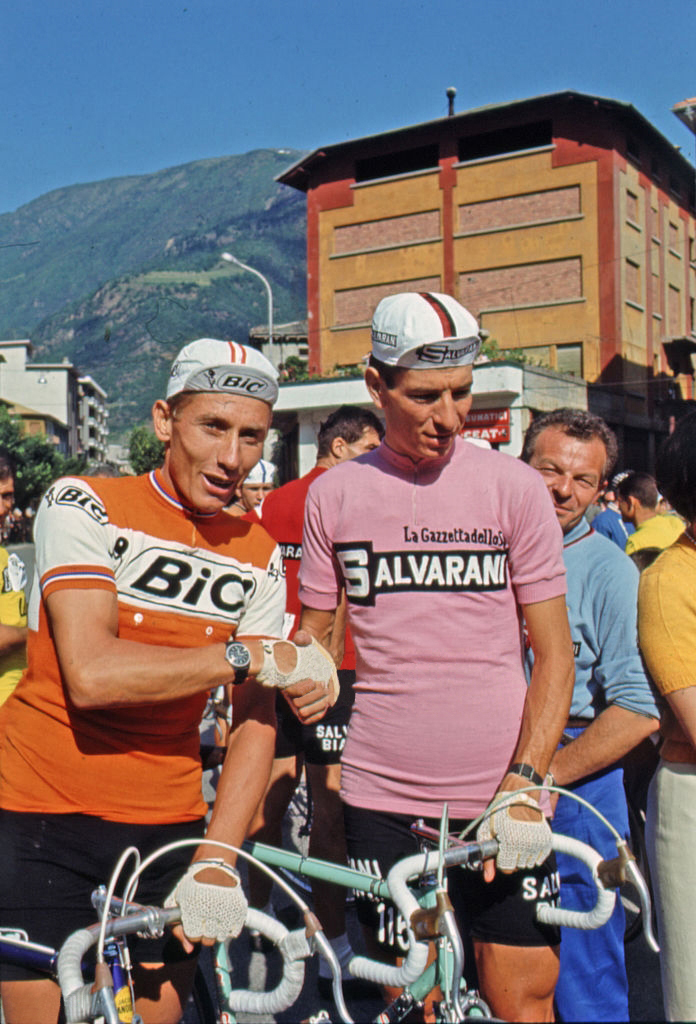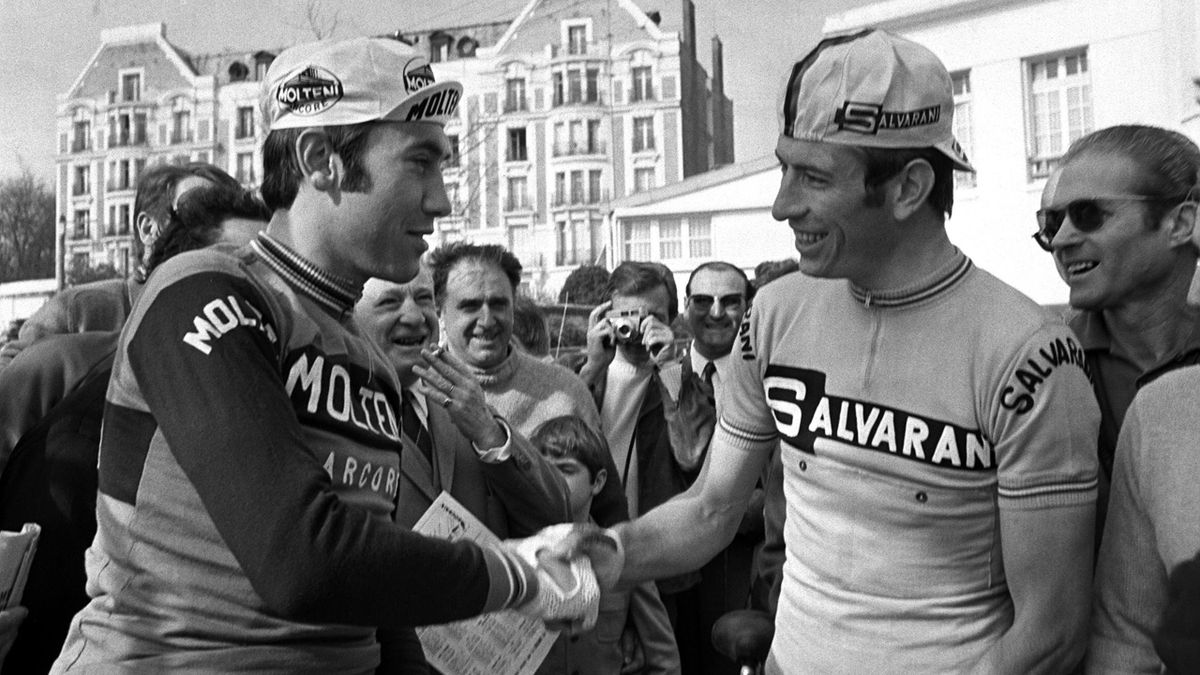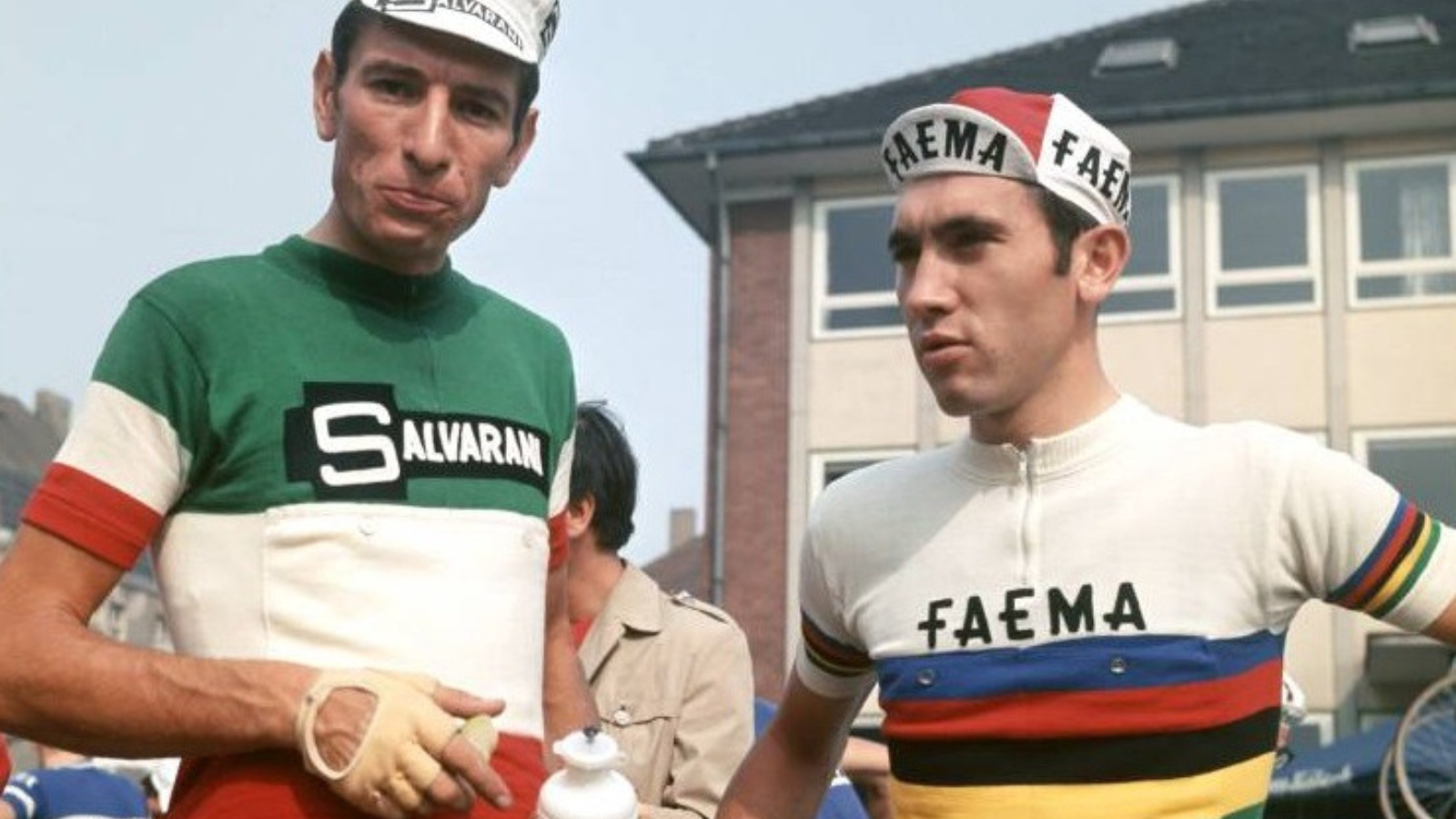Despite his career almost perfectly overlaps the years when Eddy Merckx was active, Felice Gimondi (1942-2019) managed to win pretty much everything.
Gimondi is one of the few riders won all the three grand tours at least once, he also gained the rainbow jersey and won three different monuments.
Gimondi and the grand tours
Felice Gimondi was still very young (but of course, no one can beat the record of Henri Cornet, the youngest winner ever) when he won Tour de France in 1965.
It was Gimondi’s first professional year. A few weeks earlier he rode Giro d’Italia, helped Vittorio Adorni to overall victory, while he finished in 3rd place.
He wasn’t even supposed to ride Tour de France,
but too many teammates felt out due sickness and injuries. Gimondi was kind of a last minute replacement.
Last year’s winner Jacques Anquetil skipped the race, therefore Raymond Poulidor became the biggest favourite. Everyone remembered his battle with Anquetil on Puy de Dôme. Now with the absence of his greatest rival, Poulidor’s supporters might have been pretty suremthat his time has finally arrived. Other favourites were the two Italians Vittorio Adorni and Gianni Motta. Only the latter one arrived with fresh legs.
Gimondi took the yellow jersey in the 3rd stage. He was in the breakaway with André Darrigade, a much better sprinter than him, therefore he had to try to escape from him and ride a solo to the finish line. Gimondi managed to compete this plan and won the stage. It was not only his first Tour de France stage win,
but his first professional victory ever.
Although Gimondi was supposed to keep the yellow as long as possible to please the sponsor of the Salvarani team, Adorni was still the first man and Gimondi is only his helper. When Adorni fell in the 7th stage, the entire team had to wait for him. Gimondi lost the yellow to Bernard Van De Kerckhove.
The situation became much more simple when Adorni abandoned the race, and Gimondi became the clear leader of the team. He took the yellow back in the 9th stage, a hard day in the Pyrenees, when many, including Van De Kerckhove left the race, and kept it till Paris. Poulidor, who won the stage up to Mont Ventoux became 2nd again.
Gimondi entered Tour de France 4 more times. He always finished it in the top ten. His second best result was a 2nd place behind, of course, Eddy Merckx in 1972.
But Gimondi’s real terrain was Giro d’Italia.
He won Giro d’Italia for the first time in 1967.
(Also in 1969 and 1976.) It was Jacques Anquetil’s last and Eddy Merckx’s first Giro d’Italia. The young Belgian made hin name in the inauguration stage of Blockhaus. Anquetil was a solid leader of the race until the penultimate stage when Gimondi took over the first place. After a 3rd (1965) and a 5th place (1966), he finally won his second grand tour.

In 1968 Merckx won his first Giro, Gimondi finished 3rd behind 2nd placed Vittorio Adorni, his ex-teammate, now riding for Faema and helping Merckx.
The end of the 1960s has brought a very special invention to Giro d’Italia: regular doping control was introduced. In 1968, the first year of the new system, a bunch of riders were stripped from the end result of the race a few weeks later, including previous winner Gianni Motta. In 1969, Eddy Merckx was tested positive, while riding in the maglia rosa. He was disqualified during the race, and Gimondi jumped into the first position in the GC. As a protest against the disqualification of Merckx, he did not wear the pink jersey during the 17th stage.
But the show must have gone on, and Gimondi win the Giro for the second time during his career.
The third occasion in 1976 was similar to the first one, Gimondi clamed the pink jersey almost at the very end of the race. This time the Belgian Johan De Muynck was the dissapointed other (but he managed to win the race two year later).
Fascinating fact, that
Gimondi rode Giro d’Italia between 1965 and 1978 a total of 14 times,
he completed the race every time, and only in the last two years finished outside the top ten. Both his 2nd places in overall earned in years, when Eddy Merckx was the best rider in the peloton (1970 and 1973).
Gimondi completed the grand tour triple quite early in his career.
In 1968 he won Vuelta a Espana for the first and only time.
As it was usual during the decades when Vuelta was a spring race right before Giro d’Italia, Gimondi rode it only one time. And won it. (Merckx did the same in 1974. )
Gimondi and the world championship
There are only seven riders who managed to win all the three grand tours at least once. (This article is oroginally written in January 2024, so this might change during the upcoming season.) But there are even fewer who managed to add a world champion title to it: Eddy Merckx, Bernard Hinault and Felice Gimondi.
In 1973 the World Championship was held in Barcelona (Spain.) Gimondi won the race ahead of Freddy Maertens and Luis Ocaña. Eddy Merckx arrived fourth.
According to his own words1 . Gimondi’s plan was to stick to Merkcx during the race. The Belgian attacked with 90 km to go, only five rider, including Gimondi could go with him. After a second wave of attack only four riders stayed in the leading group: Gimondi, Maertens, Ocaña and Merckx. An Italian and a Spaniard with two Belgians. When Gimondi heard Merckx and Maertens talking in Flemish, he thought that the other two made some kind of an agrement and Maertens would help Merckx during the final spint.
The two Belgians tried to distract Gimondi by a move by Maertens, but he knew he had to stick to Merckx’s wheel. Two years earlier they had a head-to-head sprint when Merckx triumped at the end, now Gimondi was able to catch the rainbow.
It was his most memorable victory over his great rival.
Nevertheless, according to Gimondi, if Maertens would sprint for himself that day he would hava win the world championship easily.

Gimondi and the monuments
As you might expect, Giro di Lombardia suited the local boy Gimondi the best. He won the race twice, in 1966 and 1973. In 1966 he had to beat Eddy Merckx, and thanks to fellow Italian Vittorio Adorni’s smart move against the Cannibal, he nailed it. In 1973, only few weeks after the world championship, the race was originally won by Merckx, but soon after he was tested positive and lost his title, which went to Gimondi.
1966 was a good year for Gimondi in terms of great one-day victories. Besides Giro di Lombardia, he also managed to win Paris-Roubaix that year.(( Just an interesting sidenote to see the phrase “in the shadow of Eddy Merckx” proven. Peter Cossins in his book about the monuments finishes his passage about Paris Roubaix 1966, the one that was won by Gimondi with the story about Jan Stablinski and Rik van Looy are talking about that young Belgian guy who seemed to be very strong at the beginning: “Jean, you will soon out all about him, he’s called Eddy Merckx.”)) (Fun fact: it was still the era before Arenberg was introduced to the race.)
He celebrated his Milano-Sanremo victory in 1974, ahead of Eric Leman and Roger de Valeminck. (Merckx was absent that year.)
Gimondi, of course rode the other two monuments too. His best result at Ronde van Vlaanderen was a 2nd palce (behind Merckx) in 1969 and at Liege-Bastogne Liege a 7th place in the same year (also won by Eddy Merckx)
- Giles Belbin: Chasing the Rainbow Jersey – The Soty of Road Cycling’s World Championships. Aurum Press. 2017 [↩]
